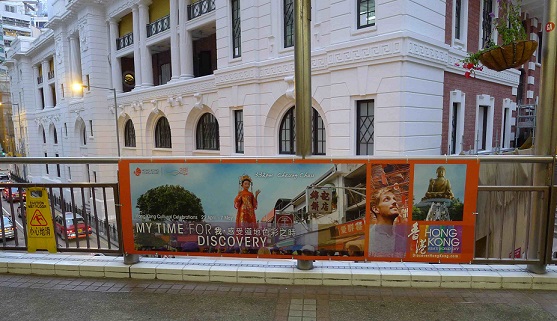藝術議題
- 藝術博覽會最新的專題文章如下。如欲閱讀有關同一議題的其他文章,可再點擊右下角資料庫的年份和月份。
An Art Boom Now?
約翰百德 (John BATTEN)
at 0:00am on 15th May 2014

Caption:
View of the Former Central Police Station under renovation with Hong Kong Tourism Board promotion material in the foreground, 2014. Photo: John Batten.
(原文以英文發表,題為「香港藝術熱潮?」。)
Optimistic art dealers and the press increasingly refer to Hong Kong’s contemporary art scene as “booming”, justifying this opinion by quoting record prices and impressive clearance rates at the city’s art auctions. Reinforcing this impression is the crowning of Hong Kong in 2012 as an art world destination by Art Basel, the world’s leading art fair, after choosing the city as its third worldwide venue, complementing its Swiss home base and Miami Beach in the US.
But impressions are beguiling. Art Basel is owned by the city government of Basel through its majority ownership of the world’s largest exhibition and trade fair company, the MCH Group. The company’s fairs cover a range of luxury products, including watches at the annual Baselworld, keenly attended by Hong Kong’s watch retailers. The expansion of Art Basel into Asia through its Hong Kong edition is further strategic branding of Basel and Swiss business worldwide, reinforced by Swiss bank UBS taking title sponsorship at this year’s Hong Kong fair, replacing Deutsche Bank.
The need for a wider geographical spread is also seen with the opening of Hong Kong branches of top ‘international’ galleries: White Cube, Gagosian Gallery, Galerie Perrotin and Lehmann Maupin. This, in part, ensures artists they represent are seen and remain under their wing worldwide and in Asia, a location gap for many European and American galleries. This is akin to having a worldwide patent on a product, whether the product is popular or not.
An added reason for expanding into Hong Kong, long appreciated by auctions houses, is its free-port status (goods can be moved in and out, no questions asked); low taxation; no import, export or VAT-type taxes; and minimal reporting requirements for the transfer of overseas funds.
Often intentionally timed to coincide with and trailing on the coat-tails of Hong Kong’s bigger art events are a range of lesser known contemporary art auctions and a glut of art fairs, some using hotel rooms as a venue. These second-tier fairs generally display decorative art and add little depth or quality to Hong Kong’s art scene.
Overseas art visitors and collectors do fly into Hong Kong for the city’s major auctions and to view the latest gallery offerings at Art Basel. This is good news for the city’s art galleries, as there is a dearth of local art collectors. A condition resulting from the most mundane of reasons: the city’s housing stock for the middle-class, a natural source of potential art collectors, is woefully small in size, lacking storage and wall space to hang art.
Mentioning Hong Kong’s high property costs is a cliché, but it is a brake on Hong Kong’s primary art market. Short-term leases and rising costs make selling art a fickle business. For a city with a population of nearly 8 million people, and yearly visitor arrivals of over 54 million people, Hong Kong has approximately 80 commercial galleries in operation, a relatively small number for its population and location in one of the world’s busiest commercial cities. No new overseas gallery has opened in Hong Kong in the last 18 months and there has been a small decrease in the total number of domestic galleries, including the closure of the long-established Schoeni Art Gallery. Business is tough.
Although art fairs attract new and potential art buyers, they are thinly spread between visiting overseas and domestic galleries competing for clients. Despite gaining great media attention, the city’s international galleries have been slow to be accepted in Hong Kong’s small and often-parochial visual art scene. Last month, White Cube recognized the need to boost visitor numbers and build momentum for their exhibitions by appointing Aenon Loo of Gallery Exit as a Hong Kong director, whose gallery has links to Hong Kong artists.
Recently, the museum-quality exhibitions of Alberto Giacometti sculpture, drawings and prints at Gagosian Gallery and Antony Gormley’s sculpture at White Cube have raised the quality benchmark for commercial gallery exhibitions in Hong Kong. This should be taken as a challenge for other Hong Kong galleries to meet. Unfortunately, for too long mediocrity is promoted, and seen, as excellence!
The raising of overall standards is also dependent on the strength and innovation of public galleries –and Hong Kong has few. This will improve with the opening of the West Kowloon Cultural District’s M+ art and design museum in 2017 and the soon-to-be renovated Hong Kong Museum of Art. A major boost to the scene will be a dedicated contemporary art centre commissioned at the renovated heritage site of the Central Police Station in 2017 – although in what form is still to be decided.
Hong Kong is not experiencing an art boom – now. And Hong Kong artists do not have big cars and apartments and their names are not art world recognized like some in the mainland - yet.
A version of this article was published in The Peak magazine, May 2014.
